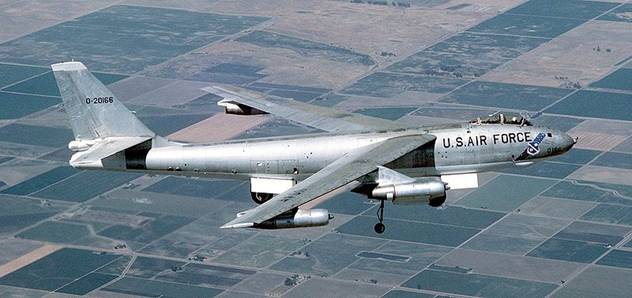B-47 FACT SHEET
By Cliff Lethbridge

B-47
Launch Status: No Longer Used for Cape Canaveral Missile Launches
First Cape Canaveral Launch: May 26, 1958
Final Cape Canaveral Launch: October 13, 1959
Total Number of Cape Canaveral Launches: 12
Vehicles Launched: Bold Orion
Function: Strategic Medium Bomber
Contractor: Boeing
Power Plant: Six GE J-47 Engines
Power Plant Thrust: 6,000 pounds each engine
Wingspan: 116 feet
Length: 107 feet
Height: 28 feet
Speed: 600 m.p.h.
Ceiling: 40,000 feet
Range: 3,000 miles (without aerial refueling)
Bomb Load/Cargo Capacity: 20,000 pounds
Armament: Two 20-millimeter cannon in tail turret
Crew: Three (Pilot, Co-pilot, Navigator/Bombardier)
Maximum Gross Takeoff Weight: 230,000 pounds
Primary Using Command: Strategic Air Command
The B-47 “Stratojet” made its maiden flight on December 17, 1947. On February 8, 1949 a test version named the XB-47 established a then record flight time from Larson Air Force Base, Washington to Andrews Air Force Base, Maryland. The 2,289-mile flight was completed in 3 hours, 46 minutes. The aircraft also completed non-stop flights over the Atlantic and Pacific Oceans, the latter of which was accomplished with in-flight aerial refueling.
B-47 aircraft also completed non-stop flights over the North Pole and other long-range flights. Once such flight covered 39,200 miles in 3 days, 8 hours, 36 minutes. Such long-range flights were accomplished through aerial refueling, as each B-47 aircraft were compatible with “flying boom” aerial fueling operations.
Follow-up production version to the original B-47 named the B-47B was first flown on April 26, 1951. The last production model, named the B-47E, was first flown on January 30, 1953. A photo reconnaissance version of the B-47E, named the RB-47E, was first flown on July 3, 1953. The first production version of the B-47 incorporated six GE J-35 engines each capable of producing a 4,000-pound thrust. Engines and engine performance were improved in later versions.
All models of the B-47 featured 35-degree sweptback wings and provision for 33 assisted takeoff (ATO) rocket units each of which could produce a 1,000-pound thrust. The unique B-47 landing gear employed dual main wheels in tandem with a single outrigger attached to inboard engine pods. The landing gear used a parabrake to slow the B-47 after landing.
A research version of the B-47, named the XB-47D, was fitted with two jet engines and two Curtis-Wright T-49 turboprops sporting four-bladed propellers each 15 feet in diameter. Used as an experimental aircraft, the XB-47D was never placed in production. Production of all B-47 aircraft ceased in 1956.
B-47 aircraft were flown in support of Bold Orion Air-Launched Ballistic Missile (ALBM) launches. Bold Orion missiles were dropped from B-47 aircraft and fired over open Atlantic Ocean waters.
.


